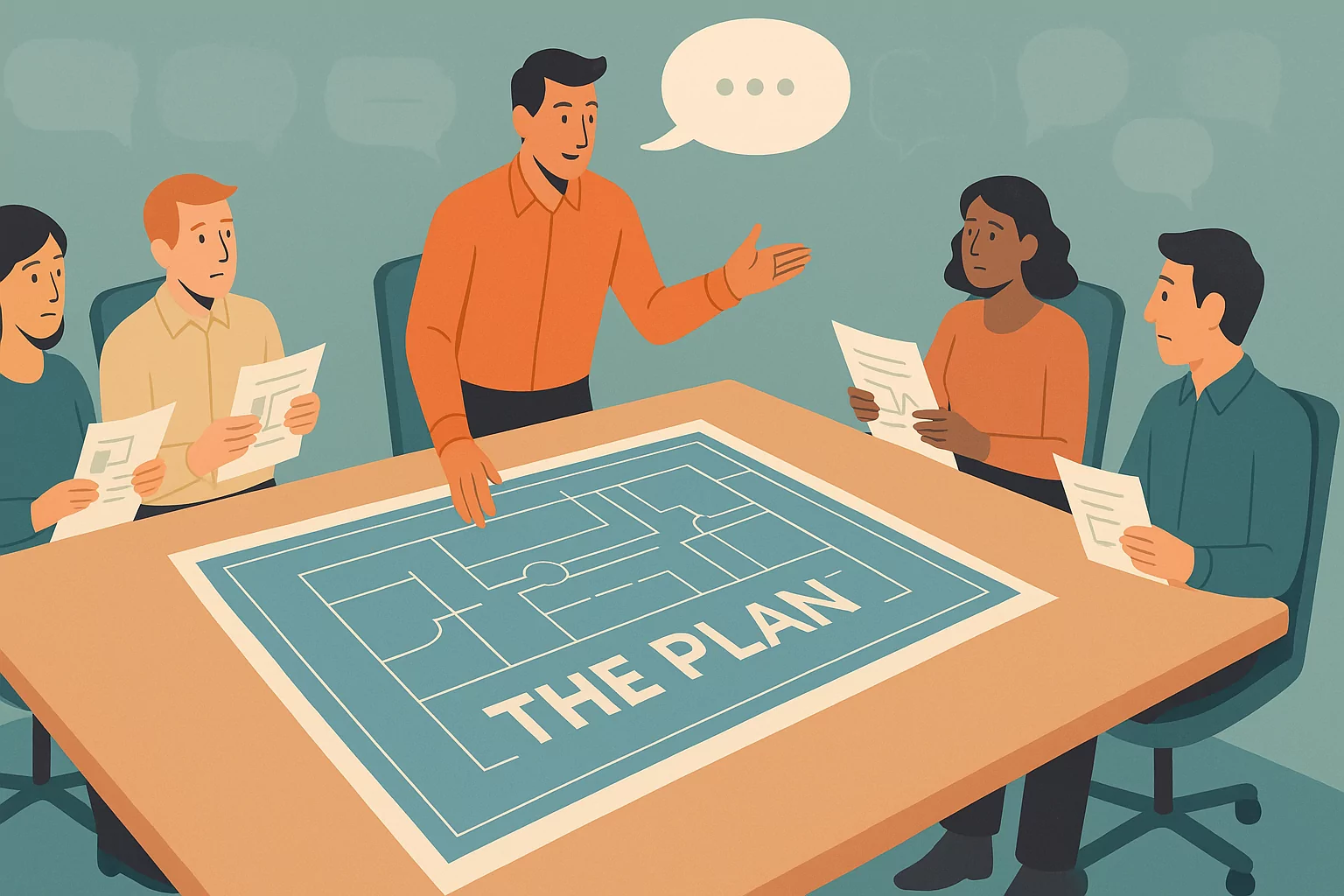
“A dialogue becomes a monologue the moment one side cares more about agreement than discovery.”
A Quick Story (Sound Familiar?)
“Let’s talk about our new software‑engineering stack and decide together.”
Five minutes in, everyone has retreated to a corner. The person who called the meeting? They’ve already drafted the stack diagram, colour‑coded, laminated, and—let’s be honest—tattooed on their heart.
Every alternative gets judged “not as good as the original” for one simple reason: it isn’t the original. The convo slowly morphs from brainstorm to public confirmation ceremony.We’ve all sat through that meeting (or family dinner, or WhatsApp thread).
It’s frustrating as hell—not because ideas clash, but because they never truly meet.
Keep that scene in mind; the rest of this piece is a toolkit for preventing the sequel.
Spotting a Fixed‑Agenda Conversation in the First 60 Seconds
Before you invest another breath, scan for these tells:
| Tell‑tale sign | What you hear/see | Corporate‑speak version that sounds open but isn’t |
|---|---|---|
| Lead with the verdict | “So here’s the plan that’ll solve this…”—dropped before any context. | “I’ve put together some initial thinking to accelerate alignment.” |
| Rhetorical questions | “Wouldn’t any sane person agree this is best?” (Spoiler: it’s not a question.) | “Don’t you think this is the most logical next step?” |
| Binary framing | “Either we do X or we fail.” | “Given our current constraints, there are really only two viable paths.” |
| Token listening | Polite nods while scrolling to the next bullet. | “Great point—let’s park that and circle back.” |
| Score‑keeping language | “As I already proved…” / “Like I said at last sprint review…” | “As highlighted in the previous deck and endorsed by leadership…” |
See two or more? You’re holding a ticket to a one‑act play—stop expecting improv.
Quick sanity check: Corporate‑speak alone isn’t the villain—it can simply be habit or shorthand. What matters is the follow‑through. If the language sounds open but the behaviour still rushes, dismisses, or railroads, you’re not in a conversation; you’re in a compliance drill.
Why / What / How — The Litmus Test for Real Dialogue
Before any debate gets spicy, pause to answer three checkpoints:
- WHY – Purpose & Criteria
• What problem are we solving?
• What constraints or success metrics matter? - WHAT – Options on the Table
• Which alternative approaches actually qualify?
• Are we adding to the list or quietly deleting contenders that threaten the pet favourite? - HOW – Process & Principles
• How will we compare options (data, prototypes, pilot run)?
• How will we decide and commit?
Red flag: If the “what” arrives fully baked while the “why” and the “how” are waved off as obvious, you’re not in a discussion—you’re in a direction dressed up for the party.
Run this checklist early. If any line is blank, fill it together before arguing whose answer wins.
Why Fixed Agendas Freeze Growth (and Goodwill)
- No fresh data enters. Facts are allowed in only if they endorse the script.
- Psychological safety evaporates. Offering a left‑field thought feels like volunteering for the dunk tank.
- Creativity stalls. Alternatives are waved away as “interesting” (code for nope), so innovation never shows up.
- Relationship debt accrues. People remember being treated as props, not partners—and they bill interest.
(Yes, this applies to product roadmaps and choosing a family holiday.)
If You’re the Audience: Five Moves to Re‑open the Door
| Move | Why it works | Pocket script |
|---|---|---|
| Surface assumptions | Exposes the hidden win‑condition. | “Just so I’m clear—what outcome can’t we leave without?” |
| Request criteria, not conclusions | Shifts debate from what to why. | “What problem does this solve, and what else could solve the same thing?” |
| Offer a test case | Adds reality friction. | “Let’s run this through a real customer story—does it still hold?” |
| Time‑box advocacy | Gives the agenda airtime, then balance. | “Cool—take five to pitch. Then five for us to stress‑test.” |
| Name the dynamic (gently) | Resets norms without nuking rapport. | “I’m noticing we might be converging fast—can we map a couple other paths first?” |
Goal: turn a verdict into a hypothesis.
If You’re the Playwright (Oops—That’s Me!)
Realise you came in loaded? Here’s the escape hatch:
- Declare your bias. “I’m leaning hard toward Stack X; help me check my blind spots.”
- Ask one sincere curiosity question. Frame something whose answer could truly change your mind.
- Invite contradicting evidence first. “What data would sink this faster than a memory leak?”
- Switch to criteria‑first language. “We need low latency under 50 ms and DevEx A‑grade—what meets that?”
- Schedule round two. Sleep on new data instead of debating while adrenaline’s still spiking.
(Side effect: you look confident and coachable—rare combo.)
Immediate Pay‑offs of Breaking the Script
- Agility. More options surface sooner; course‑correcting later costs less.
- Shared ownership. People feel responsible for the outcome, not just compliant with it.
- Learning loop. Even if the original idea wins, it’s battle‑tested and sturdier.
Call to Action — Come to Talk, Not to Win
Before you hit Send on that calendar invite—or walk into the kitchen debate about whose turn it is to cook—pause for one breath and ask:
“Am I defining the why, naming the what, and agreeing on the how—or am I just dressing direction up as discussion?”
Choose conversation. Everything good (alignment, insight, trust) flows from that fork. Choose winning and you might get the trophy—but you’ll play to an empty stadium next time.
Stick this page on your digital corkboard. When you feel the plot has been pre‑written, flip back, pick a move, and reopen the story.
Leave a Reply